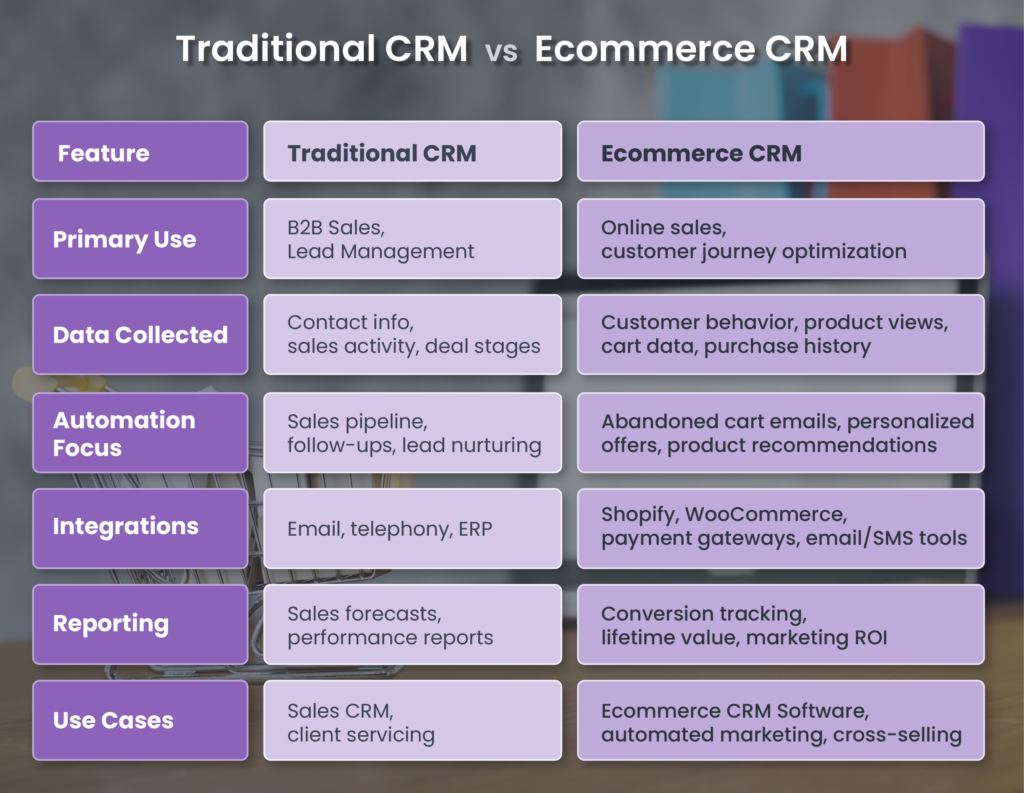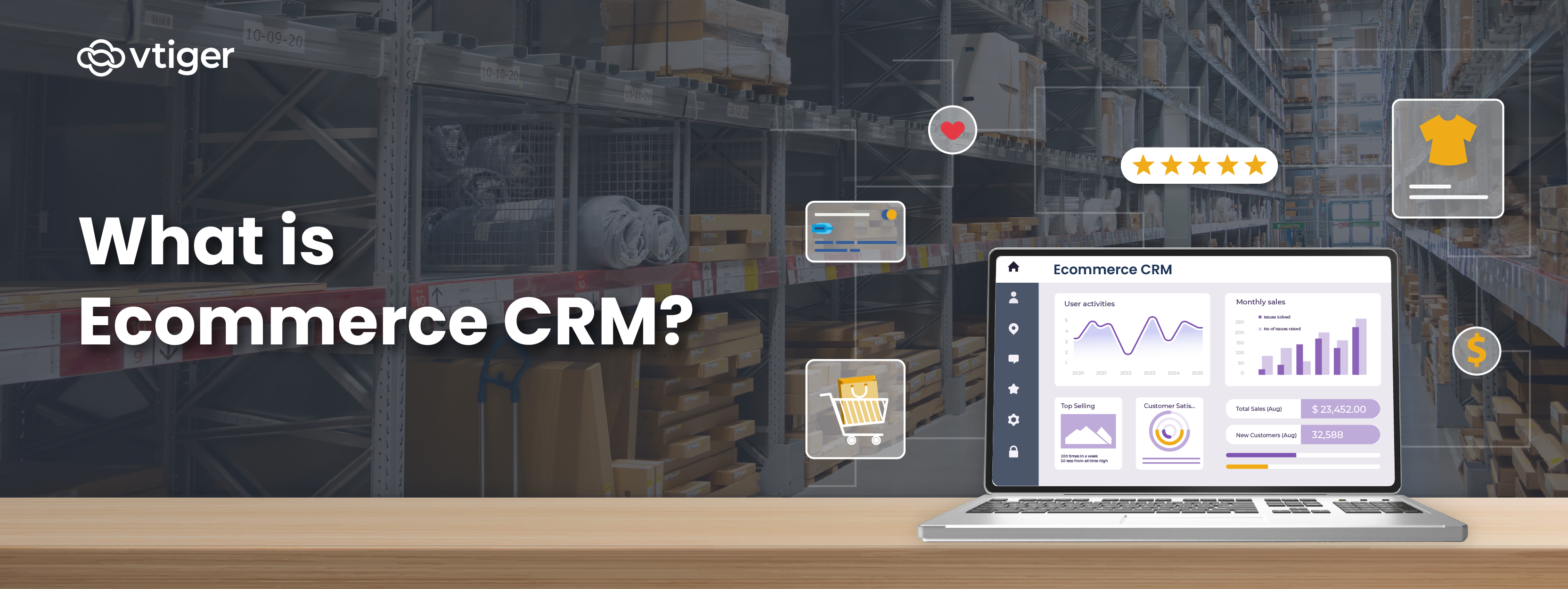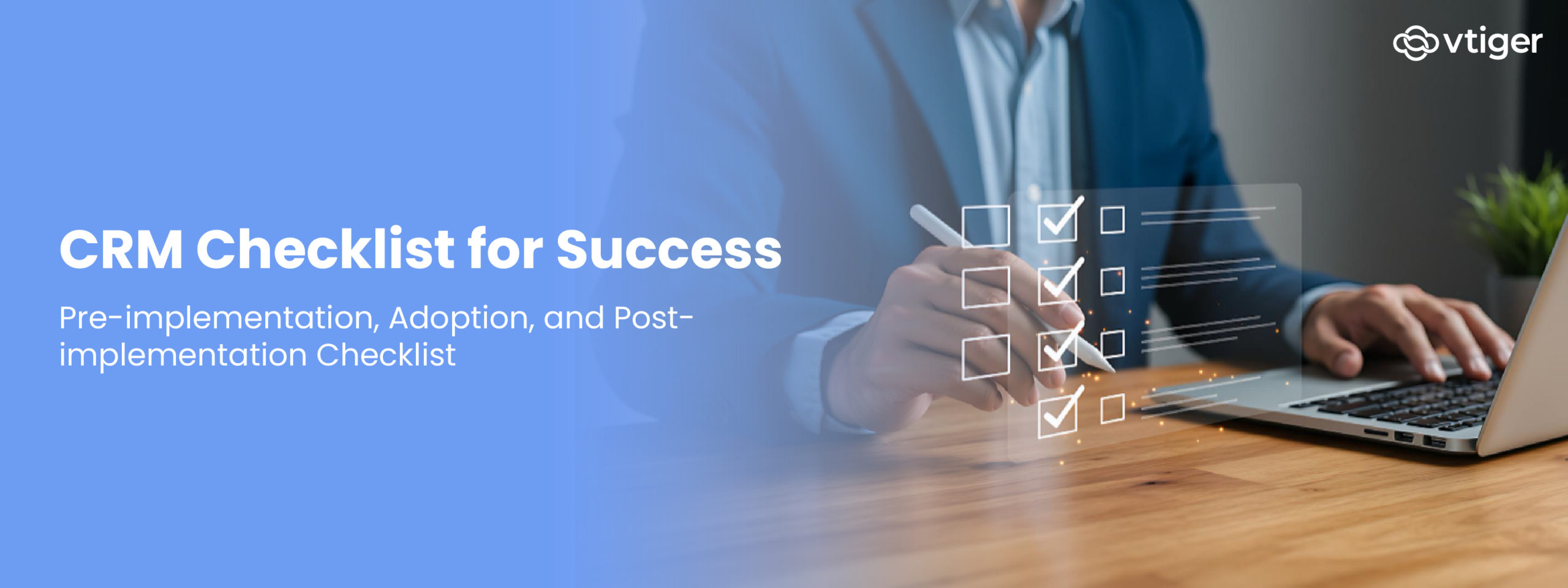What is an e-commerce CRM?
An e-commerce CRM (Customer Relationship Management) system is built to help online retail businesses manage customer data, marketing, and sales in one centralized platform. Unlike generic CRMs, which focus on long B2B cycles, ecommerce CRMs are tailored for high-volume, quick-turn customer journeys common in online stores.
They track purchase history, abandoned carts, and browsing patterns, allowing precise audience segmentation and personalized campaigns that boost repeat sales. Popular platforms like Shopify and WooCommerce integrate with these CRMs to automate follow-ups, manage loyalty programs, and forecast sales.
For e-commerce businesses, a CRM is no longer optional. It drives growth by improving customer retention, enabling targeted marketing, and streamlining operations, making it essential for scaling in a competitive digital market.
Why E-commerce Businesses Need a CRM?
The global e-commerce sector is expanding rapidly, fueled by smartphone usage, digital payment adoption, and rising consumer demand for online shopping across diverse markets. With intensifying competition and evolving customer expectations, adopting e-commerce CRM software has become essential for scalable, personalized engagement. A robust e-commerce CRM helps online retailers manage large volumes of customer data while ensuring meaningful interactions that drive long-term loyalty.
Also Read: What is a CRM
Key Reasons E-commerce Businesses Need a CRM
- Customer Lifecycle Management: Repeat buyers contribute significantly to e-commerce revenue. CRM platforms track purchase patterns, manage loyalty workflows, and automate re-engagement through lifecycle-based triggers.
- Data-Driven Personalization: Advanced segmentation enables targeted campaigns across email, SMS, and WhatsApp, optimizing customer acquisition costs and increasing average order value.
- Conversion Optimization: Timely behavioral triggers, dynamic pricing, and abandoned-cart recovery workflows reduce drop-offs and accelerate conversions.
- Operational Scalability: Cloud-based CRM software models support rapid scale-up of user accounts, campaign volumes, and integrations without significant IT infrastructure investments.
- Unified Performance Analytics: Real-time dashboards provide visibility into sales funnel performance, inventory sync, and customer journeys on various platforms such as Shopify and WooCommerce.
Key Features of an E-commerce CRM
Selecting the right e-commerce CRM software requires a clear focus on features that improve customer satisfaction, increase retention, and streamline sales operations. The following capabilities are crucial for any growth-focused ecommerce business:
Customer Profiles: A centralized database that captures contact information, preferences, interaction history, and behavioral patterns across website, app, and marketing channels ensures a single source of truth for every customer.
Purchase History Tracking: Detailed order histories help identify buying trends, enabling personalized product recommendations, targeted loyalty programs, and data-backed upselling strategies.
Email and SMS Automation: Integrated automation tools allow businesses to schedule welcome emails, transactional updates, and promotional campaigns, improving engagement while reducing manual effort.
Order Tracking: Real-time order status updates enhance post-purchase communication, improving customer experience and reducing support queries.
Segment-Based Marketing: Customer segmentation based on demographics, purchase frequency, or browsing behavior ensures precision targeting and higher campaign ROI.
Abandoned Cart Recovery: Automated reminders and incentive-based notifications help recover incomplete transactions, reducing revenue leakage.
An advanced e-commerce CRM does more than manage contacts; it aligns data, automation, and marketing intelligence to create scalable, customer-focused operations suitable for a fast-growing online retail ecosystem.
How Does an E-commerce CRM Work?
An e-commerce CRM functions as an integrated system designed to collect, organize, and act on customer data to improve engagement and sales efficiency. The workflow generally follows these steps:
- Data Collection: The e-commerce CRM software collects customer data from various digital touchpoints, such as website visits, product views, order history, payment methods, and live chat sessions.
- Customer Profile Creation: This data is organized into detailed customer profiles. These include personal details, preferences, previous purchases, cart behavior, and support tickets, providing a full picture of each customer.
- Automation Setup: Businesses can configure automation rules like welcome emails, cart abandonment alerts, and personalized offers based on specific triggers (e.g., new signup, repeat purchase, or inactivity).
- Sales & Service Tracking: The system tracks all sales activities and customer service interactions, allowing teams to deliver timely assistance, optimize conversions, and improve post-sale satisfaction.
Benefits of Using an E-commerce CRM
Implementing an e-commerce CRM delivers measurable benefits to e-commerce companies, combining data-driven strategies with customer-centric operations:
Better Customer Segmentation: An e-commerce CRM collects and analyzes real-time customer data—such as purchase habits, browsing behavior, and demographics—enabling more precise segmentation. This results in more personalized marketing campaigns with higher engagement rates and conversion potential.
Higher Retention Rates: Automated loyalty programs, purchase reminders, and personalized follow-ups help maintain consistent customer engagement. Studies show CRM users achieve up to a 27% increase in retention, a critical factor for e-commerce, where repeat purchases contribute significantly to revenue stability.
Improved Marketing ROI: Personalized messaging crafted through CRM insights outperforms generic promotions, with click-through rates over 14% higher on email, SMS, and social platforms. This leads to measurable improvements in marketing ROI and reduced ad spend wastage.
Reduced Churn: By tracking customer behaviors and flagging drop-off signals, e-commerce CRMs enable proactive retention strategies. Given that a 5% rise in retention can increase profits by 25–90%, improving churn metrics through CRM-driven insights becomes indispensable.
Easier Upselling and Cross-Selling: Detailed purchase-history tracking supports intelligent product recommendations. CRMs help identify opportunities for upselling and cross-selling at optimal moments, boosting the average order value and enhancing revenue generation with minimal acquisition costs.
E-commerce businesses evaluating e-commerce CRM must weigh these benefits against open-source CRM alternatives, as SaaS-based e-commerce CRMs often deliver faster deployment, automated updates, and advanced analytics essential for long-term profitability.
Popular Ecommerce CRM Tools(2025)
Here is a comparison of leading e-commerce CRM software platforms widely adopted with insights on pricing, scalability, and suitability for businesses of various sizes:
| Platform | Suitable For | Notable Features & Use Case |
| Vtiger CRM | Small to mid size businesses | All-in-one CRM with sales, marketing, and support automation; integrates with ecommerce platforms like Magento and WooCommerce; cost-effective for growing businesses. |
| Zoho CRM | Small to medium ecommerce | Native integration with Shopify, WooCommerce; AI insights via Zia; affordable entry point for startups and MSMEs. |
| Salesforce Commerce Cloud | Large-scale brands & enterprises | Deep integration with Salesforce ecosystem, robust AI-driven personalization, ideal for global and multi‑region commerce. |
| Freshmarketer (by Freshworks) | SMEs to mid-market ecommerce | Focused on sales and marketing automation within e-commerce. |
| HubSpot CRM | Small teams & startups | User-friendly interface, built-in email/SMS automation; excellent for businesses beginning with CRM. |
| Klaviyo | Mid-sized ecommerce brands | Small to mid-sized businesses |
E-commerce CRM vs Traditional CRM: What’s the Difference?
When exploring what is Ecommerce CRM, it’s important to understand how it differs from traditional CRM software. Here’s a quick comparison to help you decide which system suits your business needs better:

E-commerce CRM software is tailored for digital-first businesses that rely heavily on customer data, automation, and marketing integrations. While traditional CRM software helps with lead tracking and client relationships in B2B, e-commerce CRMs offer dynamic workflows focused on online behavior and conversions. If your business runs primarily online, switching to an e-commerce CRM could unlock smarter engagement and higher ROI.
Step-by-Step Guide to Implement an E-commerce CRM
1. Define Your Goals: Establish specific outcomes you expect from the e-commerce CRM software. Whether the focus is on increasing repeat purchase rates, automating lifecycle marketing, or improving customer service response time, clear objectives ensure a structured implementation.
2. Choose the Right Tool: Evaluate SaaS-based or open-source CRM options based on operational scale, customization requirements, and total cost of ownership. SaaS solutions are ideal for businesses that prioritize quick deployment, while open-source models enable more in-depth custom workflows for advanced technical teams.
3. Integrate With Your Website or Store: Connect the CRM directly with your e-commerce platform and payment systems. Real-time synchronization of order history, inventory updates, and customer activity is crucial for accurate segmentation and automated decision-making.
4. Import Existing Customer Data: Import existing databases, including transaction logs, browsing history, and interaction records, into a unified repository. Ensure data is cleaned and deduplicated to avoid reporting inaccuracies and flawed automation triggers.
5. Set Automation Rules: Set predefined triggers for core e-commerce activities such as cart abandonment alerts, reminders, post-purchase review requests, and loyalty offers. Intelligent automation directly impacts conversion rates and retention.
6. Train Your Team: Conduct training for sales, marketing, and customer success teams on CRM functionalities, including campaign creation, segmentation logic, and analytics dashboards. Proper onboarding accelerates adoption and reduces operational friction.
7. Monitor Performance: Monitor ecommerce-specific KPIs such as customer lifetime value (CLV), repeat order percentage, campaign attribution, and churn rate. Use these insights to refine targeting strategies and improve ROI.
8. Continuously Optimize: Regularly update automation rules, adjust audience segments, and test new workflows based on data-driven insights. A CRM’s effectiveness depends on ongoing optimization aligned with evolving e-commerce trends.
Even if you are preparing to deploy a full sales CRM solution, this step-by-step guide ensures a smooth implementation journey.
Mistakes to Avoid When Using E-commerce CRM
Using an e-commerce CRM effectively can drive growth, but only if you avoid these common pitfalls:
- Ignoring Data Quality
An e-commerce CRM is only as effective as the data it holds. Inaccurate, duplicate, or incomplete customer records can lead to poorly targeted campaigns and incorrect sales forecasts. Regular database audits and validation should be part of your workflow.
- Relying Too Much on Automation
Automation should enhance communication, not replace it entirely. Overuse of generic, automated messages can feel impersonal and reduce engagement. Combine automation with behavioral triggers and personalized messaging to maintain a human connection.
- Lack of Proper Segmentation
Sending the same promotions to all customers weakens campaign performance. Use advanced segmentation features within the CRM to categorize customers by purchase frequency, product preferences, or browsing behavior for targeted outreach.
- Neglecting Performance Tracking
Without analyzing key metrics such as customer lifetime value, abandoned cart recovery rate, or repeat purchase ratio, optimization becomes impossible. E-commerce CRMs come with built-in analytics—review these reports regularly to refine strategies.
- Poor Integration with Other Tools
A CRM that operates in isolation cannot deliver complete value. Ensure it integrates seamlessly with your e-commerce platform, payment gateways, and marketing automation tools. Even open-source CRM plugins should sync data across systems for unified operations.
Avoiding these mistakes will help you harness the full potential of your e-commerce CRM and build stronger, more profitable customer relationships.
E-commerce CRM for Different Business Sizes
Choosing the right e-commerce CRM depends heavily on your business size, goals, and budget. Here’s how to approach it based on where your e-commerce business stands:
Small Businesses & Startups
Startups need agility, not complexity. Lightweight e-commerce CRM software like Vtiger CRM, Zoho CRM, or Freshmarketer works well due to low cost and ease of use. These tools typically include basic automation, customer segmentation, and marketing features—perfect for building strong foundations. Consider Vtiger Open Source CRM options if your budget is tight, and ensure the tool can scale as your needs evolve. Look for open source CRM options if your budget is tight, and ensure the tool can scale as your needs grow.
Mid-Sized D2C Brands
At this stage, automation, analytics, and personalized communication become vital. A robust sales CRM like Vtiger, HubSpot, or Klaviyo offers advanced segmentation, campaign tracking, and seamless integrations with e-commerce platforms. These tools help improve conversion and retention while still being cost-efficient. Scalability becomes crucial—choose a CRM that adapts to seasonal spikes and expanding product lines.
Large E-commerce Platforms
Enterprises need a fully integrated e-commerce CRM software like Salesforce Commerce Cloud. These platforms manage complex customer journeys, omnichannel campaigns, and massive databases with ease. They also offer AI-powered insights and deep automation. While they require a higher investment, the ROI is significant when aligned with large-scale operations.
FAQs: E-commerce CRM
CRM stands for Customer Relationship Management. In e-commerce, CRM software helps online stores manage customer data, track orders, automate communication, and improve marketing efforts. The primary focus is on building better customer relationships.
While both manage customer relationships, e-commerce CRM is tailored for online stores. It focuses on order history, customer behavior, and cart activity and integrates with e-commerce platforms, unlike traditional CRM software, which is more sales-team focused.
No. E-commerce CRM software is useful for businesses of all sizes. Even small stores can benefit by improving customer service, automating emails, and tracking user behavior. Many platforms offer affordable plans for startups.
Yes. Most modern e-commerce CRM tools offer plug-and-play integrations with platforms such as Shopify, WooCommerce, Magento, and BigCommerce, enabling seamless data flow between the store and CRM.
Not necessarily. Most e-commerce CRM software comes with user-friendly dashboards. However, initial setup or advanced automation may need some technical help or onboarding support.
A CRM stores names, email IDs, phone numbers, purchase history, browsing activity, preferences, and feedback. This helps personalize communication and improve service.
Yes. By tracking customer behavior, sending timely offers, and personalizing outreach, a good sales CRM boosts customer retention and increases repeat purchases.
Reputed CRM software platforms use encryption, role-based access, and data backups to keep information secure. Always choose tools that follow data protection law.
You can start seeing benefits like improved communication and better tracking within a few weeks. Significant ROI from your e-commerce CRM like increased sales or customer retention, usually takes 2–3 months.



